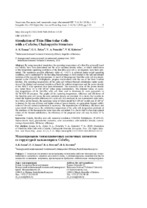Simulation of Thin-Film Solar Cells with a CuInSe2 Chalcopyrite Structure

Date
2020Publisher
Another Title
Моделирование тонкопленочных солнечных элементов со структурой халькопирита CuInSe2
Bibliographic entry
Simulation of Thin-Film Solar Cells with a CuInSe2 Chalcopyrite Structure = Моделирование тонкопленочных солнечных элементов со структурой халькопирита CuInSe2 / A. K. Esman [et al.] // Энергетика. Известия высших учебных заведений и энергетических объединений СНГ. – 2020. – № 1. – С. 5-13.
Abstract
By using numerical simulation, the operating temperatures of a thin-film solar cell based on CuInSe2 have been determined and the solar radiation density values, at which stabilization of the temperature operating conditions of the thin-film solar cell is not required, have been optimized. The maximum possible efficiency value of ~14.8 % is achieved under actual operating conditions, and is maintained by the incoming thermal energy as both emitted in this cell and infrared radiation of the sun and the environment. A model of the proposed thin-film solar cell was implemented in the COMSOL Multiphysics program environment with the use of the Heat Transfer Module. The operating temperatures of the solar cell without thermal stabilization under conditions of the diurnal and seasonal variations of both the ambient temperature and the power density of the AM1.5 solar spectrum have been determined. The maximum value of this power density was varied from 1.0 to 500 kW/m2 when using concentrators. The obtained values of operating temperatures of the thin-film solar cell were used to determine its main parameters in the SCAPS-1D program. The graphs of the operating temperature, efficiency and fill factor of the thin-film solar cell versus the solar radiation density are provided. It is shown that in order to obtain the highest possible efficiency of a solar cell, it is necessary to use concentrated solar radiation with a power density, the maximum value of which should be 8 kW/m2 in July and 10 kW/m2 in January. In the case of lower and higher values of power density, an appropriate thermal stabilization of the cell under consideration is necessary. The dependencies of efficiency, fill factor and open-circuit voltage versus the stabilization temperature of the solar cell, temperature gradients at the interfaces of the thermoelectric layer were also calculated. It is shown that by choosing optimal values of the thermal stabilization, the efficiency of the proposed solar cell may be about 15 % or more.
Abstract in another language
С помощью численного моделирования определены рабочие температуры тонкопленочного солнечного элемента на основе CuInSe2 и оптимизированы значения плотности мощности солнечного излучения, при которых не требуется стабилизация температурного режима данного элемента. Максимально возможное значение КПД ~14,8 % достигается при реальных условиях эксплуатации и поддерживается за счет поступающей тепловой энергии, как выделяющейся в этом элементе, так и инфракрасных излучений – солнца и окружающей среды. Модель предлагаемого тонкопленочного солнечного элемента была реализована в программной среде COMSOL Multiphysics с использованием модуля «Теплопередача». Определены рабочие температуры солнечного элемента без термостабилизации в условиях сезонного и суточного изменения температуры окружающей среды и плотности мощности солнечного излучения спектра AM1,5, максимальное значение которой варьировалось в пределах от 1 до 500 кВт/м2 при использовании концентраторов. Полученные значения рабочих температур тонкопленочного солнечного элемента использовались при определении основных его параметров в программе SCAPS-1D. Приведены графики зависимостей рабочей температуры, коэффициента полезного действия и коэффициента заполнения тонкопленочного солнечного элемента от плотности мощности солнечного излучения. Показано, что для получения максимально возможного КПД солнечного элемента необходимо использовать концентрированное солнечное излучение с максимальным значением плотности мощности 8 кВт/м2 в июле и 1 0 к Вт/м2 в январе. В случае более низких и высоких этих величин необходима соответствующая термостабилизация рассматриваемого элемента. Также рассчитаны зависимости КПД, коэффициента заполнения и напряжения холостого хода от температуры стабилизации солнечного элемента, градиенты температур на границах раздела термоэлектрического слоя. Показано, что при выборе оптимальных значений термостабилизации эффективность предлагаемого солнечного элемента может составлять порядка 15 % и более.
View/
Collections
- № 1[8]
